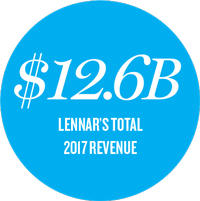UPDATED: June 22, 4:43 p.m.: The last decade of Stuart Miller’s 20-year-plus tenure as CEO of Lennar was one for the books. Before announcing his move into the role of executive chairman this past April, the Miami native — and the company — had weathered some significantly stormy weather.
Miller led Lennar through one of the worst housing collapses in U.S. history, fended off an alleged extortion scheme by a convicted fraudster and grew the company’s revenues to over $10.9 billion in 2016.
But by the summer of 2017, Miller knew he needed something else. Something big.
Despite the growing demand for single-family houses, the homebuilding industry was facing a number of pressing challenges. Material and supply costs were rising sharply, and labor shortages were making it difficult for homebuilders to find enough workers to build their homes.
For Miller, the media-shy visionary — and son of the firm’s co-founder — who’s led the now $12 billion public company since 1997, there were no immediate solutions to resolve these massive problems, sources said.
There was one move, however, that could reduce the strain: acquiring another large homebuilder. Through a major acquisition, Lennar could obtain new subcontractors while simultaneously gaining scale, more land and better negotiating power.
“If they are the biggest, it’s like Walmart, everyone wants to work with you, everyone wants to give you a better price,” said Alex Barron, founder of the Housing Research Center.
Unfortunately for Lennar, there were few acquisition options available. Most large homebuilders like Toll Brothers were led by entrepreneurs or families who had no plans of giving up control, while others were too small to alleviate any of Lennar’s challenges.
 However, Miller and Lennar’s other executives found one company that didn’t fit this mold: Virginia-based CalAtlantic Group. It was the fourth-largest homebuilder in the U.S. and the product of a rare marriage of equals, Standard Pacific Homes and Ryland Homes, in 2015. A conservative company, Lennar studied CalAtlantic for six months and traveled to all of its home communities before moving forward.
However, Miller and Lennar’s other executives found one company that didn’t fit this mold: Virginia-based CalAtlantic Group. It was the fourth-largest homebuilder in the U.S. and the product of a rare marriage of equals, Standard Pacific Homes and Ryland Homes, in 2015. A conservative company, Lennar studied CalAtlantic for six months and traveled to all of its home communities before moving forward.
On October 30, 2017, Lennar announced it had finally reached a deal valued at $9.3 billion to acquire CalAtlantic. Though the deal required that Lennar take on CalAtlantic’s $3.6 billion in debt, the acquisition would ultimately make Lennar the largest homebuilder in the country, dethroning D.R. Horton. It was also expected to lower the company’s construction costs by $50 million in 2018.
But in April, a few months after Lennar completed the deal, the company — long known for its stability — made a big announcement.
Miller said he would transition to the role of executive chairman. The move would relinquish the CEO title to someone outside the Miller family for the first time in almost five decades.
Rick Beckwitt, who had served as the company’s president since 2011, took over as CEO.
To analysts and industry onlookers, the selection of Beckwitt didn’t come as much of a surprise. But some doubt that Miller is really handing over complete control of the company to Beckwitt.
“I am sure Stuart is not going anywhere; he is still relatively young,” said Charles Brecker, a partner in Saul Ewing Arnstein & Lehr’s real estate practice in Miami. “I think that he will still be involved on the macro level.”
Beckwitt, a soft-spoken 30-year industry veteran, will now be in charge of the day-to- day operations. He will take on the seemingly gargantuan task of overseeing the integration of CalAtlantic, which has 573 home communities and 67,622 homesites.
A high-stakes game
The year 2018 will likely be one of the most important in Lennar’s history. While analysts say that none of the company’s moves should be particularly alarming for investors, they come at a difficult time for homebuilders, who are facing macroeconomic headwinds with rising interest rates, escalating construction costs and labor issues that don’t seem to be going away anytime soon.
In addition to those challenges, making one of the largest acquisitions the industry has ever seen means blending the corporate cultures and marketing strategies of two homebuilding behemoths, which is no easy feat.
 “They have history going against them,” said Megan McGrath, senior analyst of homebuilding and building products at MKM Partners, an institutional equity research, sales and trading firm. “We don’t see a ton of big [mergers and acquisitions] in this space, and when we have it has not been historically successful.”
“They have history going against them,” said Megan McGrath, senior analyst of homebuilding and building products at MKM Partners, an institutional equity research, sales and trading firm. “We don’t see a ton of big [mergers and acquisitions] in this space, and when we have it has not been historically successful.”
McGrath said there have been various reasons why these mega-acquisitions haven’t panned out for homebuilders in the past. One example she cites is Pulte Homes’ $1.3 billion acquisition of Dallas-based Centex Corporation in 2009.
The company’s homebuilding revenue before the acquisition was 60 percent more than what it was postacquisition; in 2010, its revenue was $4.6 billion, down from $6.3 billion in 2008. The company apparently had to write down a bunch of Centex’s assets, causing it to lose money.
Furthermore, when other homebuilders were focused on selling new homes and buying property at distressed prices, Pulte was instead focused on the integration of the acquisition itself rather than on the growth of its existing business, according to McGrath.
“The lesson learned there is you need to be constantly reinvesting your capital,” said McGrath. “So for Lennar, there has to be growth.”
Beckwitt said in a recent conference call with analysts that the integration is going smoothly so far. Out of CalAtlantic’s 573 communities, 100 have already been converted to Lennar products, according to Beckwitt.
But the big challenge, analysts note, is how Lennar will incorporate CalAtlantic’s homes into Lennar’s “Everything’s Included” program.
That slogan and concept originated with Stuart Miller’s father in 1989. The “Everything’s Included” program was designed to give homeowners everything they would need in a home, such as granite countertops, a covered patio and stainless steel refrigerators. For Lennar, it meant homes were built efficiently, allowing the company to maintain profit margins higher than the industry average.
“The ‘Everything’s Included’ philosophy … I don’t think that’s a marketing solution. I think they think it’s the best way to include value,” said McGrath. “They are very, very strict about that building philosophy.”
However, CalAtlantic had a different approach than Lennar, focusing more on the design of the home, with more customization and more upgrade options for luxury homes.
“They [Lennar] look at it more from an investment perspective first, with the emphasis on the aesthetics of the home as secondary,” said Barron, founder of the Housing Research Center.
Strategic alternatives
Lennar’s ascension from a small local homebuilder to an industry giant with more than $12 billion in revenues was due in part to Leonard Miller’s focus on diversifying the company’s revenue stream.
Now this strategy seems poised to change.
Before departing his position, Stuart Miller said in a conference call with analysts that he wanted Lennar to become more of a “pure-play” homebuilder, meaning that Lennar would focus solely on the homebuilding segment of its business.

In October 2017, Lennar sold its Miami headquarters to real estate investment firm Naya USA for $40 million. Lennar retains long-term leases for its office spaces there.
As part of this new strategy, the company has suggested that it is looking to find “strategic alternatives” for its Rialto Group subsidiary, which was formed after the financial crisis to purchase distressed properties. “Strategic alternatives” could mean that Lennar plans to spin off the division, which accounted for $54.3 million out of $2.6 billion in revenues the company logged in its most recent quarterly report.
Analysts said Lennar would be smart to focus on what it does best: building efficient single-family homes at a time when there is a huge shortage and high demand. The National Association of Homebuilders projects that 2018 will have a shortage of almost 400,000 new homes compared to the population growth.
How it all began
One of the most prominent examples of large-scale corporate success in South Florida, Lennar began with Arnold Rosen and Gene Fisher founding F&R Builders in Miami in 1954.
A few years later, a 23-year old Miami businessman named Leonard Miller, who owned 42 lots in what was then Dade County, bought out Fisher’s stake for $10,000.
Miller and Rosen soon began focusing on building low- and moderately priced homes throughout Florida for first-time homebuyers and retirees. The firm went public in 1971 as Lennar Corporation — a combination of Miller and Rosen’s first names — with an $8.7 million IPO.
As CEO, Leonard Miller developed Lennar’s strategy to weather economic downturns by acquiring new businesses and diversifying its revenue streams, while at the same time maintaining a strong balance sheet. In 1977, Lennar expanded outside of Florida by acquiring Mastercraft Homes and Womack Development Company in Phoenix.
Through the next two decades, Lennar started to move into new segments such as home mortgages, forming Universal American Mortgage Company in 1981, giving the company a steady new revenue stream outside of homebuilding.
This also helped Lennar do what analysts say was the key to its success: buying land at depressed prices.
“Their reputation is that they are sharp land buyers,” said Carl Reichardt, an analyst for BTIG, a financial services firm specializing in institutional trading and investment banking.
One of these deals included purchasing the real estate portfolio of AmeriFirst Federal Savings Bank, which failed in 1991, in a partnership with Morgan Stanley & Company. The portfolio consisted of huge tracts of land in South Florida, including 277 undeveloped acres close to the Sawgrass Mills outlet mall in Sunrise.
“When you look at what a homebuilding company is, it’s an asset management company and their asset is land and homes,” said David Cobb, the South Florida regional director at Metrostudy, a provider of market information on the housing industry. “They are aggressive when things look like they are at their worst.”
Keeping it in the family
Stuart Miller had always stayed close to the family business. The son of Leonard and Sue Miller, Stuart mowed the yards of Lennar model homes at age 11, and as he grew older, he performed construction work on Lennar homes.
After graduating from Harvard University and law school at the University of Miami, Miller began working for his father, rising through the ranks to become president of Lennar’s homebuilding subsidiary in 1991.
He became CEO about six years later. Miller quickly established a quirky culture at Lennar. He would open company meetings with the company’s own version of the Dr. Seuss poem “The Little Red Hen”; it was written under the pen name Dr. Stuess, a combination of Stuart and the popular author’s name, according to a Wall Street Journal report.
He instituted a number of company policies designed to make the workplace more egalitarian and friendlier. This included requiring employees to wear name tags and eliminating assigned executive parking spots.
“From what I heard, when they had their sales meeting they would all start off with 20 minutes of cheering,” said Jack McCabe, the CEO of McCabe Research & Consulting. “It’s very different from most homebuilders.”
Stormy weather
Lennar’s culture may have changed under Stuart Miller, but its growth strategy did not. In 2000, the company acquired U.S. Home Corporation for about $1.2 billion, expanding the company’s operations into New Jersey, Maryland, Virginia, Minnesota, Ohio and Colorado, according to a Securities and Exchange Commission filing. By the end of that year, the acquisition gave Lennar housing revenues of almost $5 billion.
But in 2007, an overextension of subprime mortgage lending left the housing industry and the global economy in tatters. Lennar reported losses of over $1.1 billion in net income in 2008, down from gains of $593.8 million in 2006. The company, long regarded a smart cycle timer, however, was able get by, in part by selling off assets at lower prices than they cost.
Then, in January 2009, the firm was forced to confront bogus fraud allegations from a report that compared Lennar to a Bernie Madoff-type Ponzi scheme. The author, Barry Minkow, was found to have published the fake study in a deliberate effort to drive down the company’s stock price. Reports later surfaced that Minkow had been hired by one of Lennar’s former development partners, with whom Miller had had a dispute over cash: San Diego developer Nicolas Marsch. A Florida jury awarded Lennar a $1 billion judgment more than four years later, in December 2013.
21st century and beyond
Historically, Lennar appears to have survived obstacles by constantly adapting and innovating, and it continues to do so in the digital age. The company recently announced that several features in its new homes, such as doorbells and smart locks, will be controlled by Amazon Alexa, a voice-enabled digital assistant. Analysts said that this move was clearly a strategy for recruiting millennial buyers.
“Lennar is well positioned to take advantage of the elephant in the room, which is an age demographic cohort that is just starting to get into their peak years of home ownership,” said Ralph McLaughlin, chief economist and founder of Veritas Urbis Economics. “Over the next 10 to 15 years, this demographic is going to be buying homes, and if you are providing them, you are going to do very well.”
Correction: This story has been updated to state that Stuart Miller is not retiring. He will remain active in his new role as executive chairman of Lennar.
